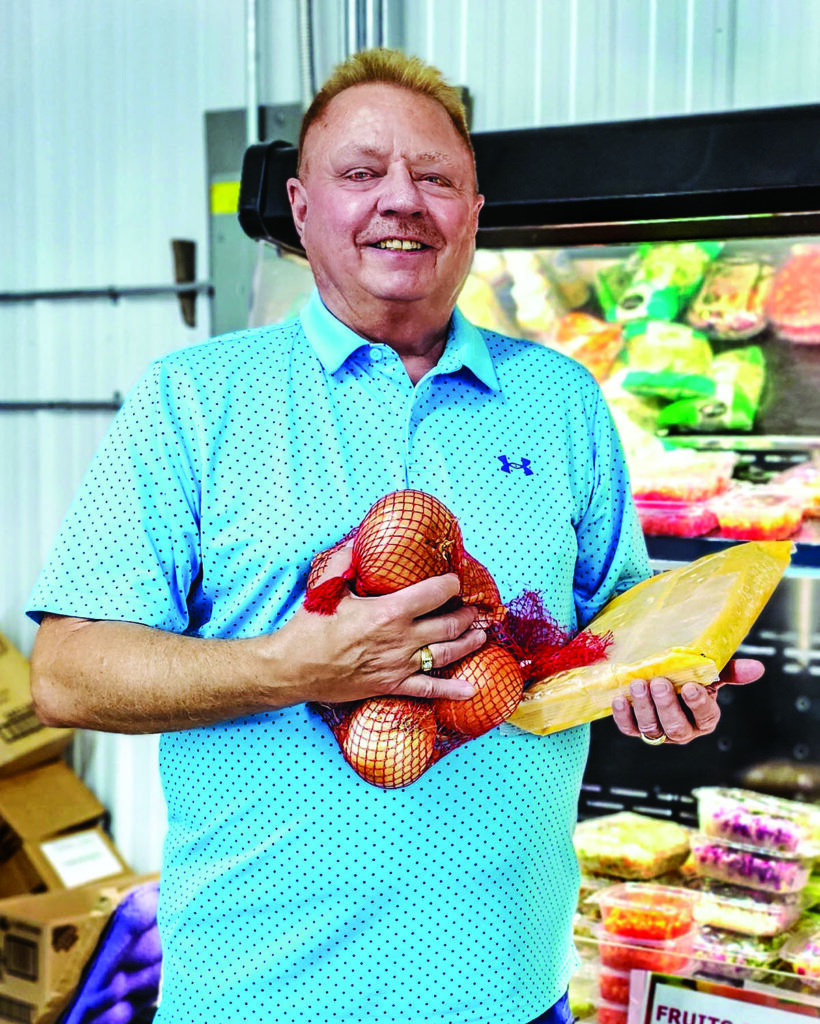Nancy Edmonds Hanson

Director Darrell Vasvick says A Place for Hope’s food bank, launched during the COVID epidemic, is now serving some 900 individuals and families every month. It’s located at 2419 12th Ave. S. in Moorhead. (Photo/Nancy Hanson.)
Back in 1998, Moorhead mental health advocates began welcoming adults with mental illness into a warm, friendly spot where they could socialize along the path to recovery and wellness. They called it the Social Connection.
The program at 2419 12th Ave. S. is still accomplishing that mission today. From arts and crafts to noon meals and playing games, its growing clientele continues to gather and build nurturing friendships with one another and dozens of volunteers. But, now known as A Place for Hope Recovery and Wellness Center, its menu of services has grown in another nurturing – or nourishing – direction. Today the nonprofit also operates one of the community’s largest food pantries, an innovation that continues to grow.
“We basically shut down during the COVID-19 pandemic,” executive director Darrell Vasvick reports, “and the board of directors was looking for other ways we could serve the community. We started on a small scale with food for our members. From there, it just grew.”
The organization opened its doors – very carefully, in those post-pandemic years – to families and individuals who qualified for food assistance under the state of Minnesota’s TEFAP guidelines. (That stands for The Emergency Food Assistance Program.)
Vasvick originally stopped at the Great Plains Food Bank to pick up donations of food products on his way to work every morning. Now, Great Plains delivers products on pallets weekly. In 2022, the pantry distributed 382,000 pounds of food over 214 days when it was open. So far this year, distribution has reached nearly 125,000.
“We serve about 900 families every month. So far this year, we have reached 3,367 families including 8,370 individuals,” the director notes. They find their way to the pantry with recommendations from Clay County Social Services and BCOW, the Becker Clay Otter Tail Wilkin Mental Health Committee, with whom the center has had contracts since its beginning 25 years ago.
However, those who use the pantry are not limited by geography. About 20% come from North Dakota communities including Fargo and West Fargo, Lisbon, Kindred and elsewhere. Many but not all Minnesota residents call Clay County home, with Detroit Lakes and Breckenridge among others. The only limitation is that all must sign a form qualifying their income according to Minnesota guidelines. Reservations are required, with two parties admitted during each 15-minute period.
Great Plains supplies the center’s warehouse with food, based on what it has on hand. That includes not only shelf-safe staples but meat, dairy products, vegetables and fruit. “We take whatever they have that will work for us,” he notes. “Many of our clients prefer ethnic diets, so we also look for foods that they prefer.” The center supplements the food bank’s deliveries by spending up to $3,000 per month on items considered essentials, including cereals, peanut butter and canned vegetables. American Crystal faithfully donates pallets of bagged sugar.
The busy food distribution side of A Place for Hope, like its mental health programs, is staffed by volunteers, who spent nearly 9,000 hours on its behalf last year. Some are community-minded individuals with an interest in mental wellness. Others are regular members of the center who pitch in in the pantry. Its biggest share of support comes from the Dilworth Lions Club, which donates countless service hours to the center. Not only that – Vasvick, who is also a member of the Fargo Sertoma Club, is now not only a member; he is the current Lions president.
Meanwhile, the social side of A Place for Hope continues to grow. After a dip caused by its mandated COVID closure, the number of clients served has been slowly regaining its former strength, with 26 newcomers bringing the total to more than 200 last year. To join the mental health program, men and women must be Clay residents and have a mental diagnosis signed by a doctor or psychiatrist.
As it has developed, A Place for Hope has adopted an eight-part focus on mental wellness. That includes a range of emphases: social, emotional, occupational, financial, physical, spiritual, intellectual and environmental elements. At the center, members can do their laundry, pursue activities from knitting to jewelry making, play pool, use computers, socialize with one another and with volunteers, and cook. The center always smells appetizing, with a full kitchen and pots simmering on the stove.
Vasvick has directed A Place for Hope since 2018. “I’d just retired for the third time,” the former printing executive recounts, “and I was looking for something to do. I saw their ad in the paper. The board told me they were looking for someone with a business background, as opposed to the social services. That sounded like me, so I applied.”
Though his contract calls for 24 hours a week, he’s on site every day. “This keeps me going. There’s no time to sit and think about myself,” he confides. “I put in 60 or 70 hours a week. I love it. When a person cares, you’re happy to put in the time.”
Some of that time is spent in an unanticipated spot – the center’s kitchen. The director himself cooks cooks up a hot, fresh lunch every day for A Place for Hope’s clients and volunteers. “Cooking is a big deal,” he observes. “After all, the way to someone’s heart is through their stomach.”
For more information on A Place for Hope’s services for those with mental illness or make an appointment to visit the food pantry, visit its website: www.aplace4hope.org … or call 218-284-6069.


